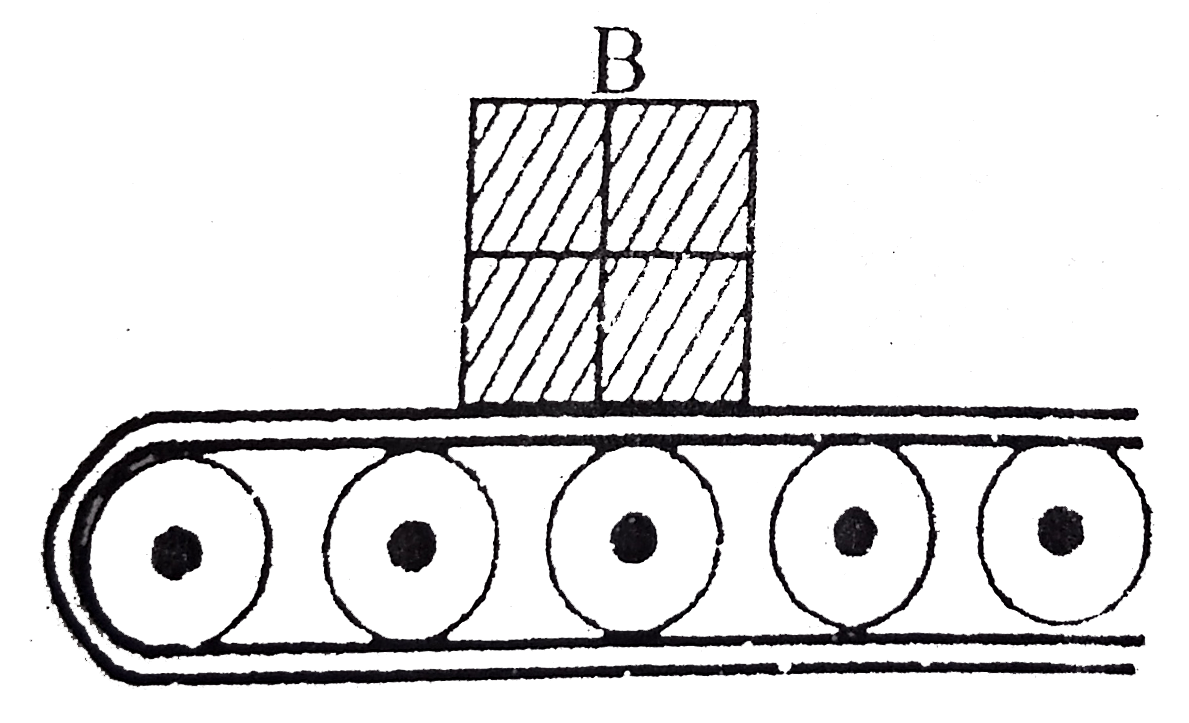A suitcase is gently dropped on a conveyor belt moving at If the coefficient of friction between the belt and suitcase is how far will the suitcase move on the belt before coming to rest ?
The correct Answer is:
To solve the problem of how far the suitcase will move on the conveyor belt before coming to rest, we can follow these steps:
Step 1: Identify the Given Values
- Initial velocity of the conveyor belt, v=3m/s
- Coefficient of friction, μ=0.5
- Acceleration due to gravity, g=10m/s2 (assuming standard value)
Step 2: Calculate the Frictional Force
The frictional force Ff acting on the suitcase can be calculated using the formula:
Ff=μ⋅m⋅g
Where m is the mass of the suitcase. However, since we are looking for distance, we can express the acceleration caused by this frictional force without needing the mass.
Step 3: Calculate the Acceleration
The acceleration a due to the frictional force can be calculated as:
a=Ffm=μ⋅m⋅gm=μ⋅g
Substituting the values:
a=0.5⋅10=5m/s2
Step 4: Use Kinematic Equation
We will use the kinematic equation to find the distance s that the suitcase travels before coming to rest:
v2=u2+2as
Where:
- v=0 (final velocity when the suitcase comes to rest)
- u=3m/s (initial velocity of the suitcase)
- a=−5m/s2 (negative because it is deceleration)
Substituting the values into the equation:
0=(3)2+2(−5)s
0=9−10s
Step 5: Solve for Distance s
Rearranging the equation gives:
10s=9⟹s=910=0.9m
Conclusion
The suitcase will move a distance of 0.9m on the conveyor belt before coming to rest.
---
- Initial velocity of the conveyor belt, v=3m/s
- Coefficient of friction, μ=0.5
- Acceleration due to gravity, g=10m/s2 (assuming standard value)
The frictional force Ff acting on the suitcase can be calculated using the formula:
Ff=μ⋅m⋅g
Where m is the mass of the suitcase. However, since we are looking for distance, we can express the acceleration caused by this frictional force without needing the mass.
The acceleration a due to the frictional force can be calculated as:
a=Ffm=μ⋅m⋅gm=μ⋅g
Substituting the values:
a=0.5⋅10=5m/s2
We will use the kinematic equation to find the distance s that the suitcase travels before coming to rest:
v2=u2+2as
Where:
- v=0 (final velocity when the suitcase comes to rest)
- u=3m/s (initial velocity of the suitcase)
- a=−5m/s2 (negative because it is deceleration)
0=(3)2+2(−5)s
0=9−10s
Rearranging the equation gives:
10s=9⟹s=910=0.9m
The suitcase will move a distance of 0.9m on the conveyor belt before coming to rest.
Topper's Solved these Questions
- LAWS OF MOTIONBook:PRADEEPChapter:LAWS OF MOTIONExercise:JEE (Main and Advanced)/ Medical Entrance Special
Explore 93 Videos
- LAWS OF MOTIONBook:PRADEEPChapter:LAWS OF MOTIONExercise:Integer Type Questions
Explore 7 Videos
- LAWS OF MOTIONBook:PRADEEPChapter:LAWS OF MOTIONExercise:Fill in the blanks
Explore 20 Videos
- KINEMATICSBook:PRADEEPChapter:KINEMATICSExercise:1 NCERT Comprehension
Explore 4 Videos
- MATHEMATICAL TOOLSBook:PRADEEPChapter:MATHEMATICAL TOOLSExercise:Fill in the blanks
Explore 5 Videos
Similar Questions
In an industry a 300 kg crate is dropped vertically from a packing mechine onto a conveyor belt moving at 1.2m/s The coefficient of kinetic friction between belt and crate is 0.4 After a short time, slipping between the belt and the crate ceases and the crate then moves along with the crate ceases and the crate then moves along with the belt . For the period of time during which the crate is being brought to rest relative to the belt, calculate, for a reference frame (a) the kinetic energy supplied to the crate (b) the magnitude of the kinetic frictional force acting on the crate, the magnitude of energy supplied by the motion (c) Why are the answers to (a) and (c) different
View SolutionA 250 g block slides on aeroug horizontal table. Find the work donen by the frictinal force in bringing the block to rest if it is initially moving at a speed of 40 cm/s. If the friction coefficient between te table and the block is 0.1 how far does the block move before coming to rest?
View Solution
Knowledge Check
A suitcase is gently dropped on a conveyor belt moving at 3m/s. If the coefficient of friction between the belt and the suitcase is 0.5. Find the displacement of suitcase relative to conveyor belt before the slipping between the two is stopped (g=10m/s2)
A2.7mB1.8mC0.9mD1.2mAn object is gently placed on a long conveyer belt moving with a speed of 5 ms−1 If the coefficient of friction between the object and the belt is 0.5, the block will slide on the belt up to a distance (Take g = 10 ms−2)
A2.0mB2.5mC3.0mD3.5mAn object is gently placed on a long converges belt moving with 11ms−1. If the coefficient of friction is 0.4, then the block will side in the belt upto a distance of
A10.21 mB15.125 mC20.3 mD25.6 m

A solid sphere of mass m and radius R is gently placed on a conveyer belt moving with constant velocity v0. If coefficient of friction between belt and sphere is 2/7 the distance traveled by the centre of the sphere before it starts pure rolling is
View SolutionA conveyer belt is moving at a constant speed of 2 ms−1 A box is gently dropped on it. The coefficient of friction between them is μ = 0.5. The distance that the box will move relative to belt before coming to rest on it, taking g=10ms−2, is
View SolutionA ball is dropped from a height of 3m. If coefficient of restitution between the surface and ball is 0.5, then the total distance covered by the before it comes to rest is
View SolutionA conveyor belt is moving at a constant speed of 2m/s . A box is grenty dropped on it. Th ecoefficient of friction between them is μ=0.5 . The distance that the box will move relative to belt before coming to rest on it taking g=10ms−2 is:
View SolutionThe conveyed belt is moving at 4m/s the coefficient of static friction between the conveyed belt and the 10kg package Bis mu_(s)=0.2 determine the shortest time in which the belt can be stopped so the the package does not slide on the belt

View Solution

